
About Andrew Cusack
 Writer, web designer, etc.; born in New York; educated in Argentina, Scotland, and South Africa; now based in London.
Writer, web designer, etc.; born in New York; educated in Argentina, Scotland, and South Africa; now based in London. read more
News
Blogs
Reviews & Periodicals
Arts & Design
World
France
Mitteleuropa
Knickerbockers
Argentina
The Levant
Africa
Cape of Good Hope
Netherlands
Scandinavia
Québec
India
Muscovy
Germany
Academica
The Mace of the Palmetto State
THE HOUSE OF REPRESENTATIVES OF SOUTH CAROLINA
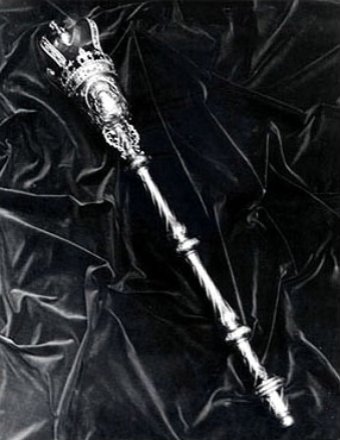
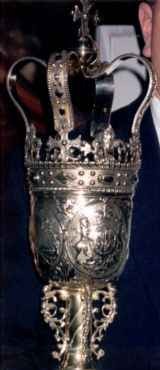 The mace currently used by the lower house of the General Assembly of South Carolina is another fine example of pre-revolutionary legislative regalia. It is a reminder of tradition in a state which takes great pride in its history and heritage. Furthermore, this ancient inheritance is still in everyday use. In 1880 the tradition of the Speaker’s procession was restored and since that year every legislative day has begun with the mace being borne by the Sergeant-at-Arms of the House, followed by the Speaker. When the Speaker reaches his chair in the House chamber, he exchanges bows with the Sergeant-at-Arms, who then places the mace upon its holster before the rostrum, exchanges bows with the Speaker once more, and thence the legislative day is called to commence. Whenever the House and Senate meet in joint session, the Mace is carried at the head of the procession.
The mace currently used by the lower house of the General Assembly of South Carolina is another fine example of pre-revolutionary legislative regalia. It is a reminder of tradition in a state which takes great pride in its history and heritage. Furthermore, this ancient inheritance is still in everyday use. In 1880 the tradition of the Speaker’s procession was restored and since that year every legislative day has begun with the mace being borne by the Sergeant-at-Arms of the House, followed by the Speaker. When the Speaker reaches his chair in the House chamber, he exchanges bows with the Sergeant-at-Arms, who then places the mace upon its holster before the rostrum, exchanges bows with the Speaker once more, and thence the legislative day is called to commence. Whenever the House and Senate meet in joint session, the Mace is carried at the head of the procession.
When the House is invited by the Senate to ratify passed legislation, the Sergeant-at-Arms bears the mace before the Speaker and the Clerk of the House in a solemn procession through the corridors of the State House, across the rotunda to the Senate chamber. There, it is put in a holding place just below the Sword of State, symbol of authority in the Senate and interesting in its own right, while the Speaker of the House, the President of the Senate, and the Clerks of both houses sign the acts.
The current Sword of State was presented on February 20, 1951 as a personal gift to South Carolina from Lord Halifax, sometime Ambassador of Her Britannic Majesty to these United States. The original Sword of State, having been made in 1704, predated the Mace, but sadly disappeared mysteriously in 1941. A cavalry sword dating from 1800 was made available by the Charleston Museum as a replacement for the 1704 Sword of State and functioned in this capacity until the gift of Lord Halifax was presented. The Sword of State features on the seal of the Senate, while the Mace denotes the seal of the House of Representatives.

The forty-eight-inch long, eleven-pound mace was crafted in 1756 by Magdalen Filene of London, believed to be the widow of the great Huguenot goldsmith, Edward Filene. The head of the mace holds four panels.
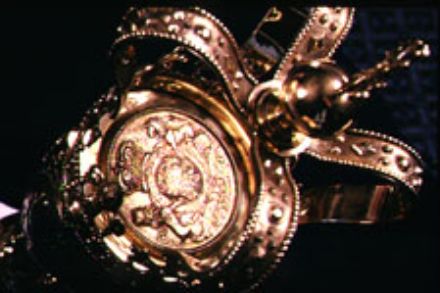 The first displays the coat of arms of George II which made up one side of the seal of the Province of South Carolina. The second panel depicts the opposite site of the provincial seal. This consisted of a seated George II, bedecked in his coronation robes, crowned holding the orb and sceptre being curtsied to by a female personification of South Carolina. The barefoot gowned personification wears a turreted civic crown symbolizing Charles Town (Charleston). Beneath the duo the provincial motto is situated: PROPIUS RES ASPICE NOSTRAS or ‘Look more closely on our affairs’.
The first displays the coat of arms of George II which made up one side of the seal of the Province of South Carolina. The second panel depicts the opposite site of the provincial seal. This consisted of a seated George II, bedecked in his coronation robes, crowned holding the orb and sceptre being curtsied to by a female personification of South Carolina. The barefoot gowned personification wears a turreted civic crown symbolizing Charles Town (Charleston). Beneath the duo the provincial motto is situated: PROPIUS RES ASPICE NOSTRAS or ‘Look more closely on our affairs’.
The third panel shows an allegory of agriculture, exhibited by the farmer at his plow, with a house and church spire in the background. The fourth and final panel is an allegory of commerce, depicting a woman sitting on a wharf holding in her right hand a ship and in her left a coin-purse. Surrounding the seated woman are bales, chests, and an anchor, while a tower, church spire, and town buildings can be seen in the background.
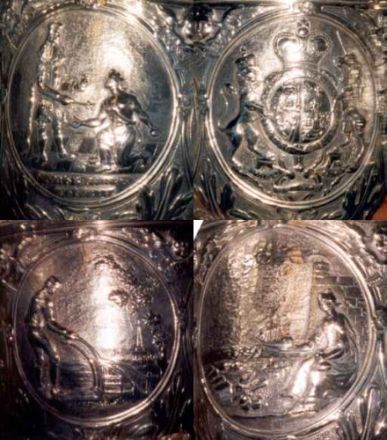
The four panels described above, beginning with the Royal Arms in the upper right hand corner and moving counterclockwise.
The mace was commissioned for 90 guineas on March 8, 1756 at the same time as robes for the Speaker and a gown for the Clerk were requested. During the Revolution, loyal Carolinians tried to raise money for the Tory side by attempting to sell the mace to the House of Assembly of the Bahamas. Apparently, the sale was approved, but never completed. The mace then disappeared until 1819 when the Hon. Langdon Cheves, a South Carolinian, discovered it in the Philadelphia vaults of the Bank of the United States (of which he was President), and was promptly returned to the Palmetto State. The last time the mace disappeared was when it was stolen on February 3, 1971. It was recovered within a fortnight and returned to the State House in Columbia where it remains today.
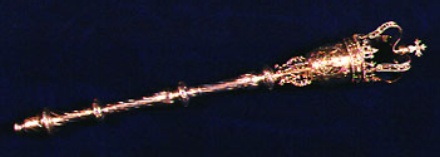
Previously:
MACES OF AMERICA, PART I: The University of the South
MACES OF AMERICA, PART II: The City of Norfolk in Virginia
Search
Instagram: @andcusack
Click here for my Instagram photos.Most Recent Posts
- Burns Tower April 19, 2024
- Patrick in Parliament March 18, 2024
- Articles of Note: 13 March 2024 March 13, 2024
- Cambridge March 9, 2024
- Taken on Trust March 4, 2024
Most Recent Comments
Book Wishlist
Monthly Archives
Categories



Here is some additional information on the SC offical mace. This information is from the 2/25/71 Gainesville Sun Newspaper. I researched this when on an official tour of the State House last week, the tour guide refused to tell this story of the 1971 theft.
The last time the mace disappeared was on February 3, 1971 when it was stolen by Charles Clayton Norton, a 35 year old Columbia, SC native and State House security guard. It was recovered by the FBI from Norton’s car in the parking lot of the Veteran’s Administration hospital in Gainesville, Florida on Febrary 25. The mace was returned to the State House in Columbia where it remains today.
My Dad is Charles Clayton Norton., and yes Feb.4,1971 he did steal the Mace from the State House.